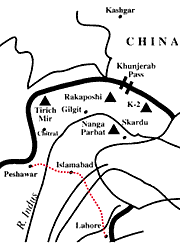

|
| |
Lahore |
| |
sightseeing |
| |
sightseeing |
| |
sightseeing |
| |
Islamabad |
| |
sightseeing |
| |
Peshawar |
| |
sightseeing |
| |
sightseeing |
| |
Islamabad |
The Grand Trunk Road was the brainchild of Sher Shah Suri (ruler of
the Indian Sub-continent) in the sixteenth century (a.d.). This road runs from
Kabul (Afghanistan) to Calcutta (India). The Grand Trunk Road Odyssey takes one
from Lahore to Peshawar through northern Pakistan's major cities in comfortable
mini-buses. This trip includes lodging in luxury hotels as well as daily meals.
Ample time is provided to absorb all the sights along this segment of the famous
highway as described below.
See Photos from a recent trip along the Grand
Trunk.
There is a local saying in Lahore--"If you have not seen
Lahore, you have not been born yet!" Lahore is the cultural heart of Pakistan.
Recently its population has ballooned, but the charm still remains. A hub of learning,
culture and history; the city is proud to be one of the centers of the Great Mughal
Dynasty that ruled India for 400 years.
It houses the Shalimar Gardens,
the great Badshahi Mosque and the renowned Lahore Fort. The British also left
their legacy in the shape of Punjab University (oldest in Asia), Rudyard Kipling's
famous "Kim's Gun" and the elite Aitcheson College for boys where the
sports tent pegging and polo are played.
There is also the sprawling inner
city protected by a medieval outer wall, large enough for elephants to pass. The
inner city has been continuously lived in for more than a thousand years! Lahore
(the city of gardens) is built along the banks of the river Ravi and is the capital
of the province of Punjab, the land of five rivers.
Traveling westward
on the Grand Trunk Road we realize the origins of its name. In the olden days
many trees were planted at the regular caravan serais along this road. These trees
have grown broad and strong providing small oasis noticeable still from some parts
of the modern highway to all passersby.
On our way to Islamabad we will
cross the huge rivers of the Punjab Province: Ravi, Chenab and Jehlum. Jehlum
is where Alexander the Great defeated the armies of Porus in a historical battle
around 300 b.c. Alexander's troops, scathed and weary, turned south towards home;
a home Alexander never saw again.
As these images of bygone days fade in
our mind's eye, the twin cities of Rawalpindi and Islamabad appear in the distance;
the former, an old British garrison town and the latter, the newly built capital
of Pakistan. Rawalpindi's busy and colorful bazaars laden with exotic wares and
carpets tantalize us while Islamabad boasts one of the largest modern mosques
in the world. Faisal Mosque can accommodate thousands of worshippers at a time.
These twin cities present a dichotomy in time between the antiquity of Rawalpindi
and twentieth century Islamabad.
Leaving Islamabad we travel westward towards
the frontier town of Peshawar. We will break our journey at Taxila where ruins
from the Gandhara civilization of 100 a.d. still stand. The Gandhara site provides
an impression of a unique culture that combined elements from Greece (through
Alexander the Great) with those of the Buddhists.
The Grand Trunk Road
then guides us over the swollen river that gives India its name, the mighty Indus.
At the town of Attock, above the Indus, we circumvent a colossal Mughal Fort and
move into the land of the tribal Pathans.
Peshawar is the home to these
strong handsome people.At Peshawar we will visit the Qissa Khawani Bazaar (the
bazaar of the storytellers). Peshawar is situated at the edge of Khyber Pass,
gateway to the Indian Sub-continent. We may have an opportunity to see this historic
pass if it is open to foreigners. Peshawar marks the end of our cultural and historical
journey through northern Pakistan. |

![]()

![]()